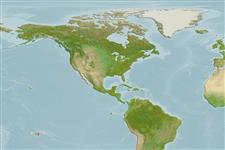>
Kurtiformes (Nurseryfishes, cardinalfishes.) >
Apogonidae (Cardinalfishes) > Apogoninae
Etymology: Siphamia: A Swazi word, siphama, for a fish; randalli: This species is named randalli in honour of Dr. John E. Randall of Honolulu, Hawai’i, for his numerous and noteworthy contributions to our knowledge of reef fish taxonomy. Jack, as he is known to friends and colleagues, is a genuine inspiration to everyone in the field of ichthyology. Moreover, Dr. Randall’s Siphamia collections at BPBM and specimen photographs, including this species, have formed an essential part of our revision (Ref. 90035).
Preferred temperature (Ref.
115969): 27.5 - 27.9, mean 27.8 (based on 16 cells).
Phylogenetic diversity index (Ref.
82804): PD
50 = 0.5000 [Uniqueness, from 0.5 = low to 2.0 = high].
Bayesian length-weight: a=0.01479 (0.00690 - 0.03171), b=3.09 (2.91 - 3.27), in cm Total Length, based on LWR estimates for this (Sub)family-body shape (Ref.
93245).
Trophic level (Ref.
69278): 3.2 ±0.4 se; based on size and trophs of closest relatives
Fishing Vulnerability (Ref.
59153): Low vulnerability (10 of 100).
